- Research Article
- Abstract
- Introduction
- Advantages of push over modal analysis
- Weaknesses of Modal overlay Analysis and Ways to fix It
- Improved Modal Pushover Method
- Optimizing The Modal Pushover Method by Considering Energy Concepts
- Advantages of Energy Methods Compared to Other Methods
- A summary of the process of the energy-based method
- Methodology
- Conclusion
- References
The Study of Modal Pushover Analysis in Structures
Seyed Ali Mousavi Davoudi* and Raha dori
Graduate of Civil Engineering, Technical University of Tabari
Submission: February 01, 2024; Published: February 19, 2024
*Corresponding author: Seyed Ali Mousavi Davoudi, Graduate of Civil Engineering, Technical University of Tabari
How to cite this article: Seyed Ali Mousavi Davoudi* and Raha dori. The Study of Modal Pushover Analysis in Structures. Ann Rev Resear. 2024; 10(4): 555794. DOI: 10.19080/ARR.2024.10.555794
- Research Article
- Abstract
- Introduction
- Advantages of push over modal analysis
- Weaknesses of Modal overlay Analysis and Ways to fix It
- Improved Modal Pushover Method
- Optimizing The Modal Pushover Method by Considering Energy Concepts
- Advantages of Energy Methods Compared to Other Methods
- A summary of the process of the energy-based method
- Methodology
- Conclusion
- References
Abstract
Pushover analysis of a nonlinear static analysis is under increasing lateral loads aim of increasing non-linear static analysis to estimate the expected behavior of a system to help estimate the structural and deformation resistance are required, by performing a nonlinear static analysis with considering the design earthquake and then the required levels of existing capacity or performance level behavior is desired. This estimation is based on the identification of important behavioral parameters including lateral, relative deformations of the members and will be connections. In the design and optimization of analytical methods based on seismic performance of structures are proposed, mainly based on nonlinear static analysis. The reason for using this type of analysis is that it is high speed, simplicity and precision of results is acceptable. However, except in cases of very specific and complex analysis or given sufficient information to demonstrate proper behavior of cyclic loading, deformation of structural members is never justified in economic terms. But based on pushover (NSP) structural response is only the first mode control, but in three-dimensional fashion discussed above, particularly the waving of the main challenges is the procedure. In order to address these challenges and proposed new methods for leveraging effect of higher modes which is one of the most important of which is modal pushover analysis, In this paper, a detailed definition of pushover analysis and modal pushover differences with static analysis method has its advantages as well as disadvantages and modal pushover analysis methods and techniques to optimize the modal pushover analysis based on the concepts of energy be provided.
Keywords: Nonlinear static analysis; Static analysis; Modal pushover; When binding; Improved
Abbreviations: MPA: Modal Pushover Analysis; NDA: Nonlinear Dynamic Analysis
- Research Article
- Abstract
- Introduction
- Advantages of push over modal analysis
- Weaknesses of Modal overlay Analysis and Ways to fix It
- Improved Modal Pushover Method
- Optimizing The Modal Pushover Method by Considering Energy Concepts
- Advantages of Energy Methods Compared to Other Methods
- A summary of the process of the energy-based method
- Methodology
- Conclusion
- References
Introduction
In the non-linear static analysis, the structure is overlaid with lateral load patterns corresponding to the mode of its vibration shapes and the capacity curve of the structure is drawn in each mode. Considering the desired accelerometer, the maximum position change of one degree of freedom is obtained and using these values, the maximum position change of several degrees of freedom is calculated. Then the structure in each mode until the specific target position changes of the same mode is under the effect of proportional lateral forces. It is covered with the shape of the desired mode. Finally, the desired responses are extracted by combining the responses obtained from each mode. In this method, it is assumed that the responses of the modes are uncorrelated in the inelastic state. Therefore, the seismic response of the structure in each mode is obtained independently from pushing the structure with a constant distribution pattern caused by the inertial forces in that mode until the change of the target location is reached. SRSS root sum of squares method is obtained [1-5]. This method gives results for elastic buildings that are equal to the well-known RSA analysis method. Because the lateral force distribution used has two characteristics (Figure 1). The maximum inelastic response of a building to earthquake excitation can be obtained by the described MPA method. This method is summarized as successive steps below:
1) We calculate the natural frequencies wn and modes φn for the linear elastic vibration of the building.
2) For the nth mode, we obtain the base shear-over-shear curve (Vbn-urn) for the force distribution S3n=m φn-3.
3) We idealize the Poshover curve as a bilinear curve (Figure 2).
4) We convert the idealized cover curve to the relation Fsn /L n-Dn.
5) We get the maximum displacement (Dn) of the nth mode inelastic one degree of freedom system.
6) The maximum displacement of the urno roof of an inelastic one-degree-of-freedom system named mode n: urno = Γn φr Dn.
7) In (urno) we obtain the values of desired responses (such as displacements of floors, relative displacement inside the floor, rotation of plastic joints, etc.
8) We repeat steps (3) to (7) for the number of necessary modes until reaching sufficient accuracy. Usually, the first two or three modes are enough (Figure 3).
9) We determine the total response by combining the maximum modal responses using the SRSS combination rule. From the total rotation of a plastic joint, we subtract the yield value of the joint rotation (ro)* to obtain the plastic rotation of the joint (Figure 4).

- Research Article
- Abstract
- Introduction
- Advantages of push over modal analysis
- Weaknesses of Modal overlay Analysis and Ways to fix It
- Improved Modal Pushover Method
- Optimizing The Modal Pushover Method by Considering Energy Concepts
- Advantages of Energy Methods Compared to Other Methods
- A summary of the process of the energy-based method
- Methodology
- Conclusion
- References
Advantages of push over modal analysis
The advantages of pushover modal analysis are as follows: The errors have a small dependence on the intensity of the earthquake, which is shown by observations from practical applications. The MPA method is equivalent to the RSA method, which is currently the standard method in engineering problems, so the errors caused by the combination of modes that exist in this method Admittedly, the fact that MPA can estimate the response of structures sufficiently in the inelastic range shows that this method is accurate enough for practical applications in building design. - The results in the studies have shown that for a certain number of modes, the errors in the MPA results are generally larger than the RHA method, although both analyzes lead to equal maximum values for the modal responses of each of the modes. In the RHA method, the errors are only caused by considering higher modes. Also, the error of not considering higher modes is small if the first three modes are considered. - Push-over analysis of a one-story inelastic system completely predicts the maximum seismic demands, which include displacement, node rotations, joint plastic rotation, etc.
However, push-over analysis inherently has limitations that cannot estimate the cumulative values of the response, for example, the energy wasted in yielding or the cumulative rotation of a plastic joint. - The maximum response of an elastic multistory building caused by the nth vibration mode can be accurately analyzed by means of static analysis of the structure under lateral loads distributed in height based on Sn =mφn where m is the mass matrix of the structure and φn is the nth mode determined and the structure until the change of the roof position determined from the maximum displacement Dn of the n-mode elastic one-degreeof- freedom system is subjected to an increasing load. has it. For this Dn system, the spectrum of the elastic design is obtained, the combination of these maximum mode responses with a suitable mode combination law such as SRSS leads to the modal pushover analysis (MPA) method. The MPA method for elastic structures is equivalent to the standard RSA method, and the nature and size of the errors caused by the approximate mode combination laws are well understood [6,7].
Modal incremental nonlinear static analysis is a very simple method based on the application of static force based on the shape of the modes to the structure. Due to the success of this method in determining the responses of structures, especially high-rise structures, extensive research has been done recently to extend it to structures with different characteristics. In this method, the seismic demand for each mode is determined separately by the inertial force distribution according to the same mode using non-linear static analysis Pushover Analysis, for the asymmetric building in the plan, this force distribution includes two lateral components and one torsional component in It is the level of each floor. Then, the responses associated with the first few modes of this modal distribution are combined by a valid mode combination law such as CQC to estimate the final non-linear response of the structure. Also, the modal nonlinear static analysis method is not sensitive to the irregularities created in the models, that is, increasing the percentage of irregularities in the models will not decrease the accuracy of the method [8,9].
- Research Article
- Abstract
- Introduction
- Advantages of push over modal analysis
- Weaknesses of Modal overlay Analysis and Ways to fix It
- Improved Modal Pushover Method
- Optimizing The Modal Pushover Method by Considering Energy Concepts
- Advantages of Energy Methods Compared to Other Methods
- A summary of the process of the energy-based method
- Methodology
- Conclusion
- References
Weaknesses of Modal overlay Analysis and Ways to fix It
Although the MPA method covers the first few modes of the structure and is more accurate than POA in this case, it still has a fundamental weakness in using the invariant pattern of lateral load distribution. - The redistribution of inertial forces after the delivery of the structure is not considered in the modal analysis. - The stiffness of the structure decreases after reaching the yield point and the subsequent displacement pattern must be changed. Therefore, secondary stiffness should be used to consider the stage after yielding.
- Research Article
- Abstract
- Introduction
- Advantages of push over modal analysis
- Weaknesses of Modal overlay Analysis and Ways to fix It
- Improved Modal Pushover Method
- Optimizing The Modal Pushover Method by Considering Energy Concepts
- Advantages of Energy Methods Compared to Other Methods
- A summary of the process of the energy-based method
- Methodology
- Conclusion
- References
Improved Modal Pushover Method
In all the modal pushover methods that have been described so far, the applied load patterns were constant during the analysis and were determined based on the dynamic and elastic characteristics of the structure. To consider the effects of changes in the modal characteristics in inelastic areas, pushover analyzes Many are presented with Modal (AM) Adaptive load pattern. In these methods, the applied load pattern in each stage of the analysis is considered based on the momentary modal characteristics of the structure updated in the dynamic characteristics of the structure resulting from the formation of joints and plastic deformations. Above mentioned, a specific method for determining the target location change is not provided, and in this method, the structure is pushed until the roof location change is equal to the value obtained from the nonlinear dynamic analysis. Also, in these methods, to scale the load patterns according to Each mode and their combination in each stage uses the elastic spectrum, while the use of the elastic spectrum in the elastic region is associated with ambiguities in the inelastic region [10].
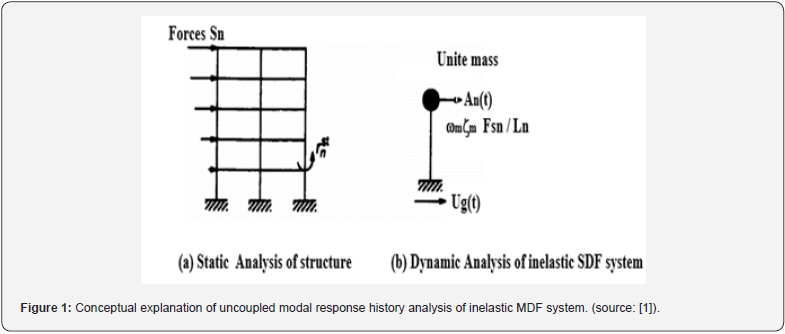
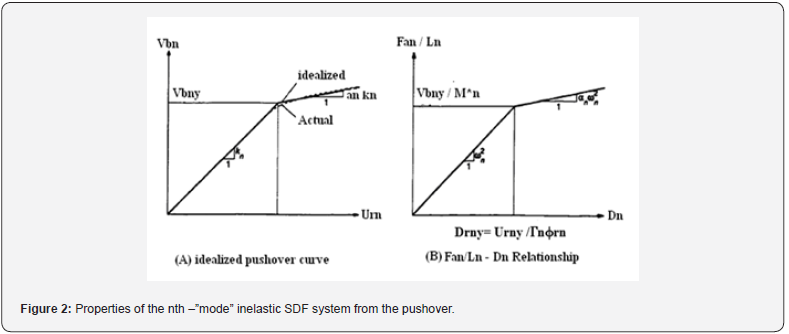
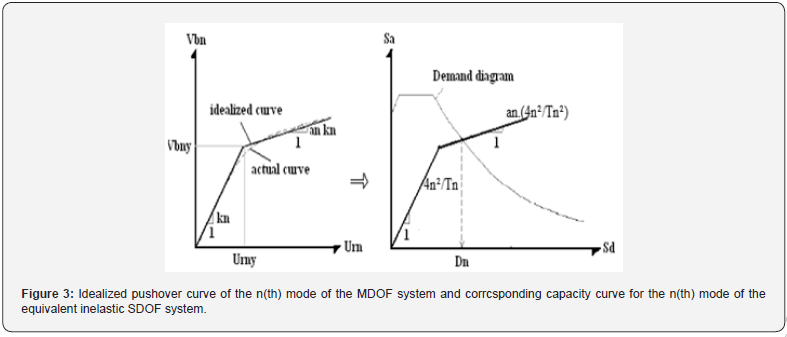
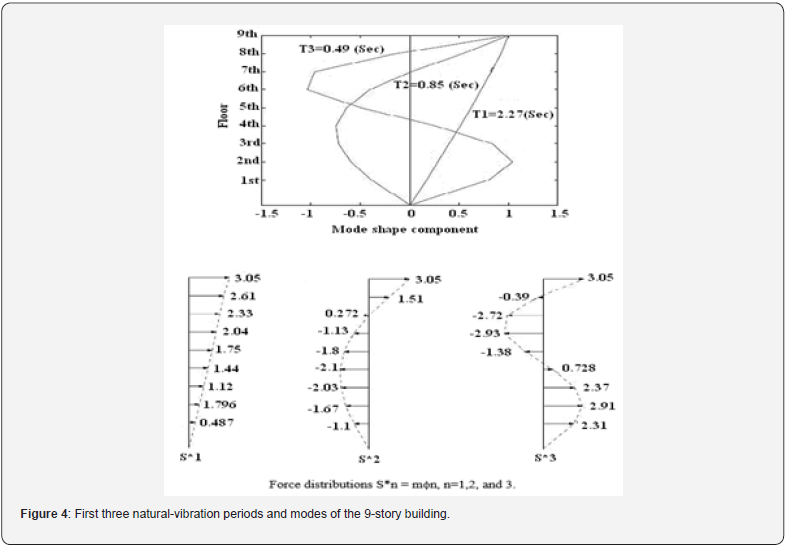
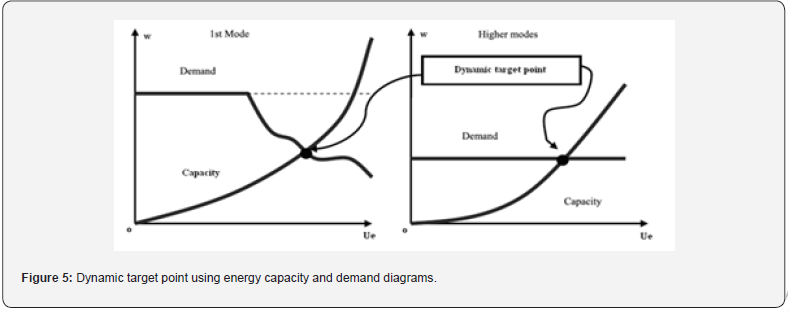
- Research Article
- Abstract
- Introduction
- Advantages of push over modal analysis
- Weaknesses of Modal overlay Analysis and Ways to fix It
- Improved Modal Pushover Method
- Optimizing The Modal Pushover Method by Considering Energy Concepts
- Advantages of Energy Methods Compared to Other Methods
- A summary of the process of the energy-based method
- Methodology
- Conclusion
- References
Optimizing The Modal Pushover Method by Considering Energy Concepts
In the MPA method, in fact, the response of a multi-degreeof- freedom system is obtained by combining the responses of multiple single-degree-of-freedom systems. The reason for the formation of the mechanism in the structural system is for the movement of the roof in the opposite direction, and it decreases with the increase of the foundation shear. To solve this problem, Hernandomentes and his colleagues presented the method of push-over modal analysis based on the concept of energy for the first time. The concepts of energy are mixed with the concepts of the capacity spectrum and while considering the effect of higher modes assuming the structure in the linear elastic region, the modal energy spectrum and the demand diagram of the structure are made, which is determined by the intersection of these two dynamic target points (Figures 5 & 6).
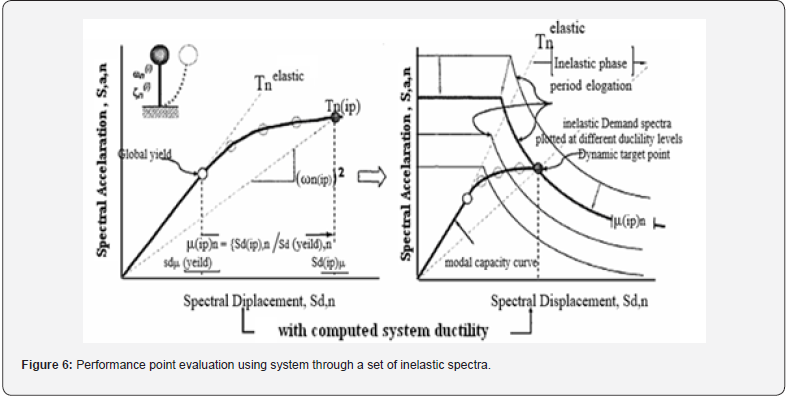
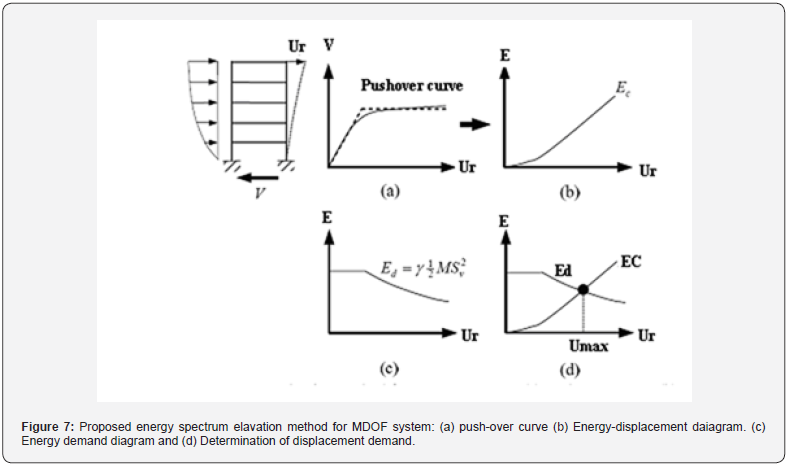
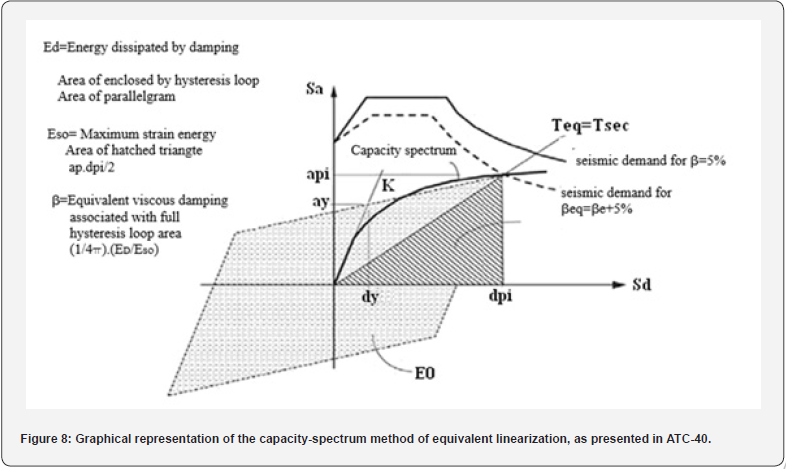
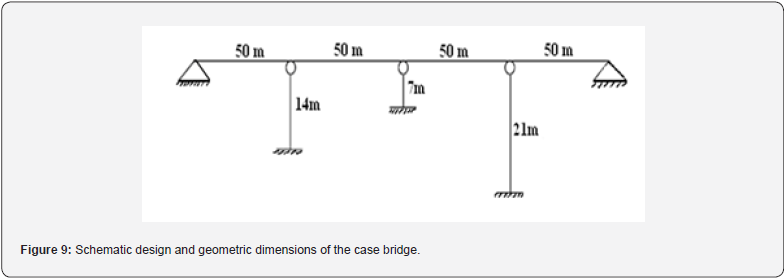
- Research Article
- Abstract
- Introduction
- Advantages of push over modal analysis
- Weaknesses of Modal overlay Analysis and Ways to fix It
- Improved Modal Pushover Method
- Optimizing The Modal Pushover Method by Considering Energy Concepts
- Advantages of Energy Methods Compared to Other Methods
- A summary of the process of the energy-based method
- Methodology
- Conclusion
- References
Advantages of Energy Methods Compared to Other Methods
i) In this method, the effects of the movement of the fault near the ground can also be seen in the analysis.
ii) Investigating the secondary hardness in the inelastic region.
- Research Article
- Abstract
- Introduction
- Advantages of push over modal analysis
- Weaknesses of Modal overlay Analysis and Ways to fix It
- Improved Modal Pushover Method
- Optimizing The Modal Pushover Method by Considering Energy Concepts
- Advantages of Energy Methods Compared to Other Methods
- A summary of the process of the energy-based method
- Methodology
- Conclusion
- References
A summary of the process of the energy-based method
1) Constructing the modal spectrum diagram of capacity energy from ESDOF system by lateral load distribution in comparison with energy-based displacements.
2) Constructing the modal diagram of the energy demand of the ESDOF system under the influence of a specific movement from the ground.
3) Determining the intersection point of these two diagrams, which is like the operating point in the capacity spectrum method.
4) Using the modal combination because of which it is possible to estimate the seismic demand of each modal lateral load distribution (Figures 7 & 8).
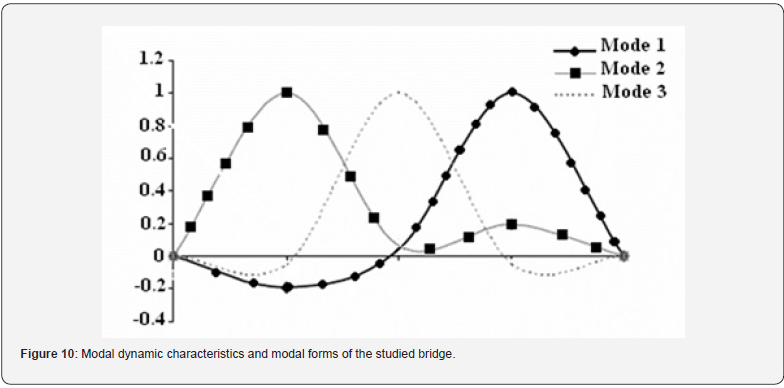
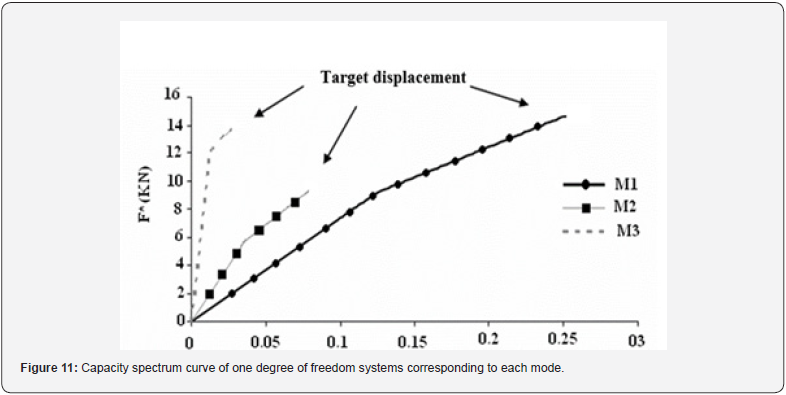
- Research Article
- Abstract
- Introduction
- Advantages of push over modal analysis
- Weaknesses of Modal overlay Analysis and Ways to fix It
- Improved Modal Pushover Method
- Optimizing The Modal Pushover Method by Considering Energy Concepts
- Advantages of Energy Methods Compared to Other Methods
- A summary of the process of the energy-based method
- Methodology
- Conclusion
- References
Methodology
The studied sample is a four-span structure with single middle foundations, which is shown schematically in Figure 9. The length of all openings is equal to 50 meters, and the height of the middle foundations is equal to 14, 7, 21 meters, which are considered as single columns with approximate dimensions of 2.4 meters. The geometry of the studied structure, in terms of the height of the foundations, the length of the deck and the number of openings, is very close to one of the laboratory samples studied by Pinto in line with the development of the Eurocode 2/8 standard, which is known to the earthquake engineering community and is recognized by the researchers. Another one has been studied as an example of an irregular structure [11-13]. The deck of the said structure is modeled in the prepared computer program as a universal elastic beam with two main joints with intermediate supports. The middle supports are modeled as springs with bilinear behavior. The mass of the structure is applied as concentrated point masses equal to 1250 tons in each of the middle supports. Figure 10 shows the modal dynamic characteristics and elastic modal shapes of the mentioned model (Tables 1 & 2).
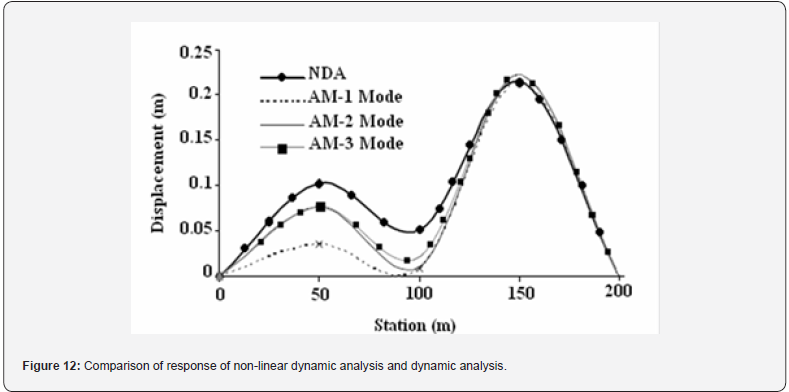


The proposed coating method is applied on the sample structure under study and the spectrum curves of the systems of one equivalent degree of freedom corresponding to each mode are shown in Figure 11. The target displacement, or in other words, the maximum displacement of each support in the loading stage corresponding to the target displacement of each mode, is shown in Table 3. The overall response of the structure is approximated by combining the root sum of the squares of the responses from each of the modes. The maximum displacement predicted by the timed modal overlay method and Nonlinear Dynamic Analysis (NDA) is shown in (Figure 12) is shown. According to the number of modes considered in the proposed AM method, the resulting answers in three different modes and considering the combination of the first two or three modes and based on the first mode only are given in Figure (4). The number of considered modes in each mode is indicated by the number written on the right side of AM in Figure 12. As it can be seen, the AM method has good accuracy and with the increase of the number of considered modes, the accuracy of the mentioned method increases. The findings and the resulting answers are close to the answers of non-linear dynamic analysis [14,15].

- Research Article
- Abstract
- Introduction
- Advantages of push over modal analysis
- Weaknesses of Modal overlay Analysis and Ways to fix It
- Improved Modal Pushover Method
- Optimizing The Modal Pushover Method by Considering Energy Concepts
- Advantages of Energy Methods Compared to Other Methods
- A summary of the process of the energy-based method
- Methodology
- Conclusion
- References
Conclusion
To develop the application of load bearing analysis for structures, a method of modal load analysis with timed load model is presented, which considers the effects of higher modes and the changes made in the modal characteristics due to plastic deformations in this article. By examining and studying an irregular structural sample and performing a timed modal overlay analysis, we observed that in forming the modal capacity curves, the concept of energy and work done in all the supports was used, and the existing ambiguities related to the selection of the point location. There was a control (base support) in the bearing curve of the structures, it has been removed. In this sample analyzed by the timed modal push-over method, it was observed that in forming the capacity curve, the location change created in all the supports is used, and finally, the accuracy and efficiency of the proposed timed modal push-over method in forecasting By studying seismic responses on this sample structure, it was shown that the output of the analysis was very close to the nonlinear dynamic analysis method.
- Research Article
- Abstract
- Introduction
- Advantages of push over modal analysis
- Weaknesses of Modal overlay Analysis and Ways to fix It
- Improved Modal Pushover Method
- Optimizing The Modal Pushover Method by Considering Energy Concepts
- Advantages of Energy Methods Compared to Other Methods
- A summary of the process of the energy-based method
- Methodology
- Conclusion
- References
References
- Chopra AK, Goel RK (2001) A modal pushover analysis procedure to estimate seismic demands for buildings: Theory and preliminary evaluation. Report No.PEER 2001/03. Berkeley (CA): Pacific Earthquake Engineering Research Center. University of California.
- Chopra AK, Goel RK (2002) A modal pushover analysis procedure for estimating seismic demands for buildings. Earthq Eng Struct Dyn 31(3): 561-582.
- Chopra AK, Goel RK, Chintanapakdee C (2004) Evaluation of a modified MPA procedure assuming higher modes as elastic to estimate seismic demands. Earthq Spectra 20(3): 757-778.
- Chopra AK, Goel RK (2004) A modal pushover analysis procedure to estimate seismic demands for unsymmetric-plan buildings. Earthq Eng Struct Dyn 33(8): 903-927.
- Chopra AK, Goel RK (2005) Role of higher-mode pushover analyses in seismic analysis of buildings. Earthq Spectra 21(4): 1027-1041.
- Jan TS, Liu MW, Kao YC (2003) An upper-bound pushover analysis procedure for estimating the seismic demands of high-rise buildings. Eng Struct 26(1): 117-128.
- Poursha M, Khoshnoudian F, Moghadam AS (2009) A consecutive modal pushover procedure foestimating the seismic demands of tall buildings. Eng Struct 31(2): 591-599.
- Hernandez-Montes E, Kwon OS, Aschheim MA (2004) An energy-based formulation for first and multiple-mode nonlinear static (Pushover) analyses. J Earthq Eng 8(1): 69-88.
- Tjhin T, Aschheim M, Hernandez-Montes E (2006) Observations on the reliabilityof alternative multiple-mode pushover analysis methods. J Struct Eng Arch 132(3).
- Gupta B, Kunnath SK (2000) Adaptive spectra-based pushover procedure for seismic evaluation of structures. Earthq Spectra 16(2): 367-391.
- Kalkan E, Kunnath SK (2006) Adaptive modal combination for nonlinear static analysis of building structures. J Struct Eng 132(11): 1721-1731.
- Park HG, Eom T, Lee H (2007) Factored modal combination for evaluation of earthquake load profiles. J Struct Eng 133(7): 956-968.
- Shakeri K, Shayanfar MA, Kabeyasawa T (2010) A story shear-based adaptive pushover procedure for estimating seismic demands of buildings. Eng Struct 32(1): 174-183.
- Antoniou S, Pinho R (2004) Advantages and limitations of adaptive and nonadaptive force-based pushover analysis. J Earthq Eng 8(4): 497-522.
- Antoniou S, Pinho R (2004) Development and verification of a displacement-based. J Earthq Eng 8(5): 643-661.






























